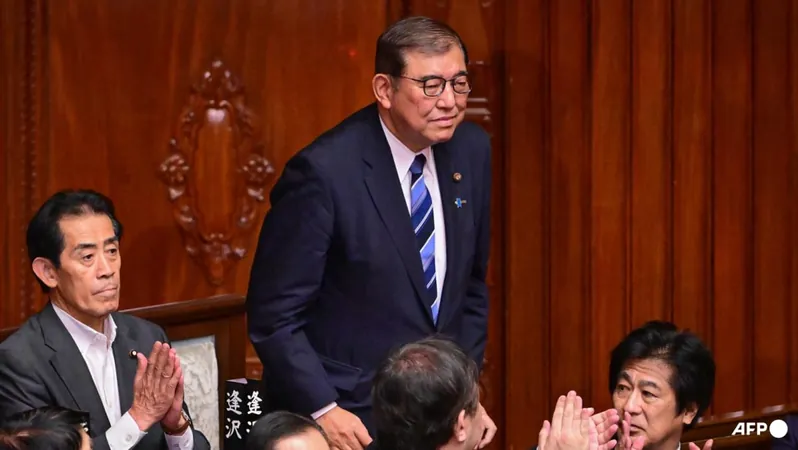
Japan's Shigeru Ishiba Launches Cabinet in Preparation for October Snap Election
2024-10-01
Tokyo – In a strategic move to consolidate power and mend divisions within his party, Japan's newly appointed Prime Minister Shigeru Ishiba unveiled his cabinet on Tuesday, October 1st, just weeks ahead of a crucial snap election scheduled for October 27th.
Having recently emerged victorious in a tightly contested leadership battle for the ruling Liberal Democratic Party (LDP), the 67-year-old Ishiba was officially confirmed as Prime Minister by parliament earlier that day. His first press conference is set to take place in Tokyo later today, where he is expected to outline his vision for Japan's future.
Ishiba's approach to foreign policy is poised to take center stage, particularly his aim to redefine Japan's relationship with the United States. Known for advocating for a more equitable partnership, Ishiba's diplomatic insights will be under scrutiny as he prepares for potential challenges, especially from an increasingly assertive China.
One of his more provocative proposals includes the establishment of a regional security alliance akin to NATO, specifically tailored for Asian nations. This idea, while ambitious, has already sparked criticism from U.S. officials for being overly hasty and has the potential to escalate tensions with Beijing.
With Japan facing rising living costs and a slew of scandals within the LDP, Ishiba's governance will be tested not only by economic pressures but also by regional security threats posed by North Korea's nuclear ambitions and Chinese military activities.
In efforts to mend fences within his party, Ishiba appointed a blend of allies and competitors to key cabinet posts. Notably, he has placed Katsunobu Kato, a former rival, as finance minister, and retained Yoshimasa Hayashi in the crucial role of chief cabinet secretary. Kato's tenure will be closely monitored, especially as he continues fiscal policies rooted in the expansionist strategies of former Prime Minister Shinzo Abe.
The stock market responded in kind to Ishiba’s leadership: following his victory, the Nikkei index witnessed a significant drop of nearly 5%, largely attributed to a stronger yen. However, recovery was observed the following day, indicating market volatility as investors adjust to the new political landscape.
In a consequential development, Ishiba's ally, Takeshi Iwaya, steps in as foreign minister, while Gen Nakatani has made a return to the defence ministry. Yoji Muto, a former junior minister, will now manage the economy, trade, and industry ministry.
Echoing his commitment to fortifying Japan’s security in light of recent territorial challenges from both China and Russia, Ishiba faces the complex task of unifying a sometimes fractious party. Notably, several leadership candidates from the primaries have been left out of important roles in government, including Sanae Takaichi, who was narrowly defeated. This decision could heighten tensions and complicate Ishiba's ability to govern effectively.
As Japan gears up for the election, opposition leader Yoshihiko Noda has signaled that the opposition party will focus on scrutinizing the LDP’s scandals. Noda emphasized on NHK, "We cannot establish proper governance through a pseudo-regime change."
Despite internal and external challenges, it appears the LDP is likely to maintain its grip on power due to the weak opposition landscape. A recent survey by the Mainichi newspaper revealed that around one-third of voters support the LDP, compared to 15% for the main opposition.
Interestingly, over half of those surveyed, including some opposition supporters, expressed optimism about Ishiba's leadership, suggesting a possibly hopeful outlook amid uncertainties. As the election date nears, all eyes will be on Ishiba’s ability to navigate these turbulent waters and secure a mandate that not only empowers his administration but also addresses the pressing concerns of the Japanese populace.





 Brasil (PT)
Brasil (PT)
 Canada (EN)
Canada (EN)
 Chile (ES)
Chile (ES)
 España (ES)
España (ES)
 France (FR)
France (FR)
 Hong Kong (EN)
Hong Kong (EN)
 Italia (IT)
Italia (IT)
 日本 (JA)
日本 (JA)
 Magyarország (HU)
Magyarország (HU)
 Norge (NO)
Norge (NO)
 Polska (PL)
Polska (PL)
 Schweiz (DE)
Schweiz (DE)
 Singapore (EN)
Singapore (EN)
 Sverige (SV)
Sverige (SV)
 Suomi (FI)
Suomi (FI)
 Türkiye (TR)
Türkiye (TR)